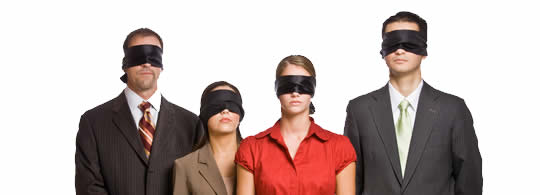No-Attention Branding

Advertisers strive to maximize attention and engagement. They want people to remember seeing their ads. They want maximum brand recall. But it’s possible to have marketing impact without ANY of those things.
Blindsight
It’s not commonly known that in addition to our main visual processing system, we have a secondary, more primitive system that feeds directly into our subconscious. The most amazing demonstration of this is the phenomenon of blindsight. Studies of individuals blinded by brain damage show how blindsight works. The video below is fascinating not just because the man navigating around the obstacles is blind, but because he has no conscious knowledge of how he is doing it.
But is blindsight just rudimentary light/dark or outline perception? Surprisingly, the answer is no – “emotional blindsight” exists as well:
In an earlier experiment, one of the authors of the new paper, Dr. Alan Pegna of Geneva University Hospitals, found that the same African doctor had emotional blindsight. When presented with images of fearful faces, he cringed subconsciously in the same way that almost everyone does, even though he could not consciously see the faces. The subcortical, primitive visual system apparently registers not only solid objects but also strong social signals. [Emphasis added. From the New York Times – Blind, Yet Seeing: The Brain’s Subconscious Visual Sense by Benedict Carey.]
Deaf Hearing, Too
It’s not just visual inputs that have multiple processing pathways. In an experiment with rats, famed neuroscientist Joseph LeDoux showed that the rodent subjects were still frightened by a bell they had been conditioned to fear, even after their auditory cortex was surgically destroyed. The rats weren’t consciously aware of hearing the bell, but they still reacted.
No-Attention Branding
Since most of your customers don’t suffer from rare brain afflictions, is this knowledge of any use? Here, we’ll have to speculate a bit. To my knowledge, there haven’t been any neuromarketing studies (say, using fMRI or EEG) that directly examine the blindsight phenomenon, particularly in subjects with normal vision. But, we DO know that consumers process brand information without being consciously aware of it.
 In Low Attention Branding, I described research that showed a statistically significant lift in positive brand perception even when viewers did not remember seeing the ad. Blindsight isn’t the only explanation for unconscious branding, though. As I discussed in Subliminal Messages Work!, brain scans showed that the visual cortex (our main vision processing center, not involved in blindsight) could also be activated without our conscious awareness. And in Subliminal Branding in Milliseconds, I wrote about research that showed exposures as short as five milliseconds – far too quickly to register consciously – caused subjects to prefer specific images when they viewed them later.
In Low Attention Branding, I described research that showed a statistically significant lift in positive brand perception even when viewers did not remember seeing the ad. Blindsight isn’t the only explanation for unconscious branding, though. As I discussed in Subliminal Messages Work!, brain scans showed that the visual cortex (our main vision processing center, not involved in blindsight) could also be activated without our conscious awareness. And in Subliminal Branding in Milliseconds, I wrote about research that showed exposures as short as five milliseconds – far too quickly to register consciously – caused subjects to prefer specific images when they viewed them later.
The neuromarketing takeaway from all this is that reinforcing your brand message is important even when consumers don’t seem to be paying attention. Colors, shapes, scents, names, logos, and so on may be subconsciously processed and stored. Needless to say, positive associations are better. Do you want your brand to be remembered in the context of a frustrating wait or a rude associate? Wouldn’t a welcoming smile or a pleasing scent be better?
The subliminal image research suggests that ANY exposure is better than none, and can cause a positive association later. So even when you have little control over the context of your branding message, don’t assume that just because the customer didn’t “see” it that it had no impact.
Image(s) via Shutterstock
